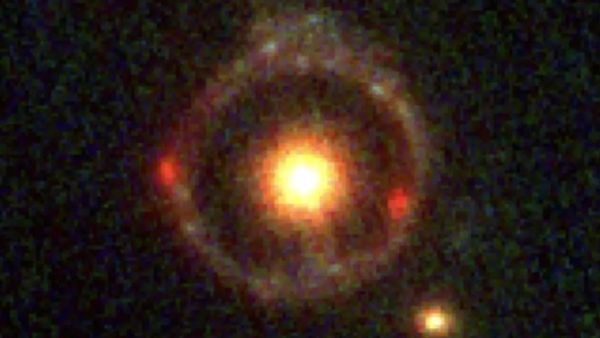
Exotic ‘Einstein ring’ suggests that mysterious dark matter interacts with itself (Image Credit: Space.com)
A fresh analysis of a remarkably massive yet compact galaxy from the early universe suggests that dark matter interacts with itself.
The galaxy, JWST-ER1, which formed just 3.4 billion years after the Big Bang, was first spotted last October in images snapped by NASA’s James Webb Space Telescope (JWST). At over 17 billion light-years from Earth, JWST-ER1g is the farthest-ever example of a perfect “Einstein ring” — an unbroken circle of light around the galaxy, a result of light rays from a distant, unseen galaxy being bent due to the space-warping mass of JWST-ER1.
The cosmic mirage is not just a pretty sight from a lucky alignment of galaxies; it also offers physicists a valuable probe for model-independent measurements of the mass enclosed within the ring’s radius.
By calculating just how much JWST-ER1g has warped space-time around itself, the discovery team had estimated that the galaxy weighs about 650 billion suns, which makes it a peculiarly dense galaxy for its size. By subtracting the visible stellar mass from the total inferred mass, physicists can measure how much of the galaxy is dark matter, an invisible substance thought to make up over 80% of all matter in our universe.
Despite decades of observations and heaps of circumstantial evidence, the elusive substance is yet to be directly detected. In JWST-ER1g, the discovery team determined that dark matter explains just about half the mass gap, and that “additional mass appears to be needed to explain the lensing results,” according to the discovery paper, which was published last fall.
“The value for the dark matter mass seems higher than expected,” Hai-Bo Yu, a professor of physics and astronomy at the University of California, Riverside (UCR) and a co-author of the new study, said in a statement. “This is puzzling.”
In a new paper, Yu and his colleagues suggest that JWST-ER1g’s unusually high density could be explained by a higher population of stars than currently thought. However, a contraction mechanism by which ordinary matter — the stuff that makes up gas and stars — “collapses and condenses” into JWST-ER1g’s dark matter halo could be packing “more dark matter mass in the same volume, resulting in higher density,” study lead author Demao Kong of UCR said in the same statement.
The halo of dark matter, densest at the galaxy’s center, is the gravitational glue that prevents spinning galaxies from flying apart. Furthermore, models incorporating a certain type of dark matter, in which its particles interact with themselves, provide “an excellent fit to the measurement of JWST-ER1,” according to the new study.
We don’t yet know what dark matter actually is. Observational clues suggest it is a new kind of particle whose presence can only be inferred from its gravitational interactions with ordinary matter. Dark matter could be just one kind of particle or a complex variety of different types, like in normal matter, that perhaps operates in the presence of additional, hitherto unknown forces exclusive to dark matter.
Last December, Yu led simulations of formations of structures incorporating self-interacting dark matter which concluded that such self-interactions could explain extremely dense dark matter halos in certain galaxies, as well as puzzlingly low densities in others, both of which are unexplained by the prevailing “cold dark matter” theory.
Physicists hope JWST can shed more light on dark matter, so to speak. The telescope’s unprecedented infrared eyes peer further back in time than any other telescope, and its upcoming investigations of galaxies from the very early universe could reveal clues about dark matter particles and their behavior, said Yu.
“We expect to see more surprises from JWST and learn more about dark matter soon.”
The new study was published April 11 in The Astrophysical Journal Letters.





